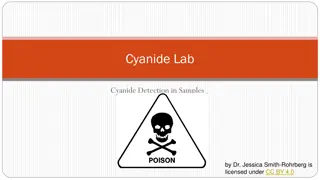Cyanide's Impact on Respiration Through Enzyme Inhibition
Cyanide, a noncompetitive inhibitor of the enzyme cytochrome c oxidase, disrupts electron transport in respiration by binding to the iron cofactor and blocking electron transfer to oxygen. This lethal effect was utilized in gas chambers during WWII, underscoring the crucial role of enzyme function in cellular respiration and highlighting the devastating consequences of enzyme inhibition on vital biological processes and organism survival.
Download Presentation

Please find below an Image/Link to download the presentation.
The content on the website is provided AS IS for your information and personal use only. It may not be sold, licensed, or shared on other websites without obtaining consent from the author.If you encounter any issues during the download, it is possible that the publisher has removed the file from their server.
You are allowed to download the files provided on this website for personal or commercial use, subject to the condition that they are used lawfully. All files are the property of their respective owners.
The content on the website is provided AS IS for your information and personal use only. It may not be sold, licensed, or shared on other websites without obtaining consent from the author.
E N D
Presentation Transcript
BILL OPENER- Cyanide Slide Show by Kelly Riedell/Brookings Biology LEARNING OBJECTIVE ENE-1.F Explain how changes to the structure of an enzyme may affect its function. ESSENTIAL KNOWLEDGE ENE-1.F.1 Change to the molecular structure of a component in an enzymatic system may result in a change of the function or efficiency of the system LEARNING OBJECTVE ENE-1.G Explain how the cellular environment affects enzyme activity ESSENTIAL KNOWLEDGE ENE-1G.4 Competitive inhibitor molecules can bind reversibly or irreversibly to the active site of the enzyme. Noncompetitive inhibitors can bind allosteric sites, changing the activity of the enzyme. SP 6.E Predict the causes or effects of a change in, or disruption to, one or more components in a biological system based on a. Biological concepts or processes. b. A visual representation of a biological concept, process, or model.
http://usmle.biochemistryformedics.com/wp-content/uploads/ETC.pnghttp://usmle.biochemistryformedics.com/wp-content/uploads/ETC.png HOW DOES CYANIDE AFFECT RESPIRATION? During WWII prisoners in Nazi concentration camps were killed in gas chambers using Cyclon B. This gas contained CYANIDE, an noncompetitive inhibitor of the enzyme cytochrome c oxidase. Cyanide binds to the iron cofactor in this complex and prevents the passing of electrons from cytochrome c oxidase to oxygen at the end of the electron transport chain. EXPLAIN WHY THIS WOULD KILL SOMEONE. PROVIDE EVIDENCE TO SUPPORT YOUR CLAIM.
http://usmle.biochemistryformedics.com/wp-content/uploads/ETC.pnghttp://usmle.biochemistryformedics.com/wp-content/uploads/ETC.png HOW DOES CYANIDE AFFECT RESPIRATION? During WWII prisoners in Nazi concentration camps were killed in gas chambers using Cyclon B. This gas contained CYANIDE, an noncompetitive inhibitor of the enzyme cytochrome c oxidase. Cyanide binds to the iron cofactor in this complex and prevents the passing of electrons from cytochrome c oxidase to oxygen at the end of the electron transport chain. EXPLAIN WHY THIS WOULD KILL SOMEONE. PROVIDE EVIDENCE TO SUPPORT YOUR CLAIM.
http://usmle.biochemistryformedics.com/wp-content/uploads/ETC.pnghttp://usmle.biochemistryformedics.com/wp-content/uploads/ETC.png HOW DOES CYANIDE AFFECT RESPIRATION? During WWII prisoners in Nazi concentration camps were killed in gas chambers using Cyclon B. This gas contained CYANIDE, an noncompetitive inhibitor of the enzyme cytochrome c oxidase. Cyanide binds to the iron cofactor in this complex and prevents the passing of electrons from cytochrome c oxidase to oxygen at the end of the electron transport chain. EXPLAIN WHY THIS WOULD KILL SOMEONE. PROVIDE EVIDENCE TO SUPPORT YOUR CLAIM.
http://usmle.biochemistryformedics.com/wp-content/uploads/ETC.pnghttp://usmle.biochemistryformedics.com/wp-content/uploads/ETC.png HOW DOES CYANIDE AFFECT RESPIRATION? During WWII prisoners in Nazi concentration camps were killed in gas chambers using Cyclon B. This gas contained CYANIDE, an noncompetitive inhibitor of the enzyme cytochrome c oxidase. Cyanide binds to the iron cofactor in this complex and prevents the passing of electrons from cytochrome c oxidase to oxygen at the end of the electron transport chain. EXPLAIN WHY THIS WOULD KILL SOMEONE. PROVIDE EVIDENCE TO SUPPORT YOUR CLAIM.
http://usmle.biochemistryformedics.com/wp-content/uploads/ETC.pnghttp://usmle.biochemistryformedics.com/wp-content/uploads/ETC.png HOW DOES CYANIDE AFFECT RESPIRATION? During WWII prisoners in Nazi concentration camps were killed in gas chambers using Cyclon B. This gas contained CYANIDE, an noncompetitive inhibitor of the enzyme cytochrome c oxidase. Cyanide binds to the iron cofactor in this complex and prevents the passing of electrons from cytochrome c oxidase to oxygen at the end of the electron transport chain. EXPLAIN WHY THIS WOULD KILL SOMEONE. PROVIDE EVIDENCE TO SUPPORT YOUR CLAIM.
http://usmle.biochemistryformedics.com/wp-content/uploads/ETC.pnghttp://usmle.biochemistryformedics.com/wp-content/uploads/ETC.png HOW DOES CYANIDE AFFECT RESPIRATION? Cyanide is an inhibitor of the enzyme cytochrome c oxidase (also known as aa3) in the fourth complex in the membrane of the mitochondria of cells. It attaches to the iron within this protein. The binding of cyanide to this cytochrome prevents transport of electrons from cytochrome c oxidase to oxygen. As a result, the electron transport chain is disrupted, meaning that the cell can no longer aerobically produce ATP for energy. Tissues that mainly depend on aerobic respiration, such as the central nervous system and the heart, are particularly affected. Antidotes to cyanide poisoning include hydroxocobalamin and sodium nitrite which release the cyanide from the cytochrome system, and rhodanase, which is an enzyme occurring naturally in mammals that combines serum cyanide with thiosulfate, producing comparatively harmless thiocyanate.























